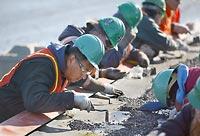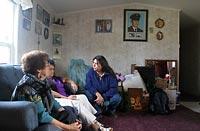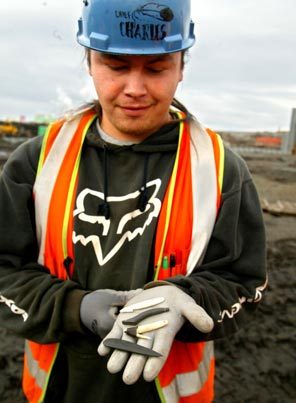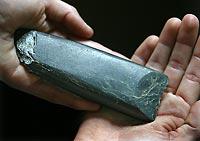Originally published May 25, 2005 at 12:00 AM | Page modified March 16, 2010 at 4:59 PM
Site teaching Klallam tribe "who we were, who we are"
The archaeological site at Tse-whit-zen gave an impoverished tribe good-paying jobs but also something much more valuable: a link to its past. But the abrupt shutdown of a state project there created tensions that linger in Port Angeles.
Seattle Times staff reporter
STEVE RINGMAN / THE SEATTLE TIMES
Lower Elwha Klallam tribal member John Parker looks for artifacts and bits of human remains in earth disturbed at a construction site in Port Angeles. Tribal members say the inadvertent discovery of their ancestral village was both a blessing and a curse. Saddened by destruction of parts of Tse-whit-zen and disturbance of hundreds of graves, some tribal members also see a cultural revival sparked by the find.
STEVE RINGMAN / THE SEATTLE TIMES
Lower Elwha Klallam tribal chairwoman Frances Charles, right, tells elders Bea Charles, left, and Adeline Smith that she is sorry they weren't consulted about the dry-dock project that unearthed an ancient tribal village. An era of forced assimilation created a gap in the tribe's own cultural knowledge.
After working at the dry-dock site, tribal member Phillip Charles found himself thinking like his ancestors, working to make these replicas of stone tools uncovered at Tse-whit-zen. "To actually get out there and find things your great-great-grandpa may have used, it was pretty exciting. I would try to imagine who these people were, what they looked like, how their lives were."
PORT ANGELES — Phillip Charles never figured he'd find himself making stone fish hooks and knives from deer bone.
But after six years of working a cash register, at first one mini-mart, then another, then a gas station, Charles took a job at the Tse-whit-zen archaeological site.
He spent six months digging his ancestors' bones and handmade tools from the ground. The cedar burial boxes he unearthed amazed him.
"You could still see where they used a hand adze to get the perfect flatness on them," he said. "You could still see the chip marks where they worked on it."
Charles was one of more than 100 Lower Elwha Klallam tribal members who worked at the site last year.
The small, rural tribe has no casino. Many Lower Elwha work for the tribal government or fish. The only business on the reservation is a tiny grocery and smoke shop. Unemployment is high. So the archaeological dig proved the best employer the tribe ever had.
But these were no ordinary jobs.
For Charles and many other Klallams, the inadvertent discovery during a state construction project of an archaeological site dating back at least 2,700 years was both a blessing and a curse.
Parts of the village were destroyed, both in the construction project and the archaeological excavation. Many tribal members dug their ancestors' remains out of the ground by hand.
But the project also offered people like Charles a face-to-face encounter with their history and helped spark a cultural rebirth of the tribe.
The Lower Elwha are sharing what they learned at the site with other tribes and the public in language classes, public-school curriculum and community presentations.
For some tribal members, the learning is just beginning.
This adze, a chisel-like tool made from nephrite, a dense stone, was used for a variety of woodworking jobs from hollowing out a feast bowl to constructing a canoe.
Finding the handmade tools of their ancestors was a bright spot for tribal members working to move the skeletons of those ancestors from the path of construction.
Working at the site got Charles, 27, thinking about how his ancestors lived, how they fished, and the tools they made. Actually holding bone and stone tools his great-great-grandfather might have used inspired Charles to try replicating them.
He quickly figured out how hard that was: Working a piece of obsidian with the point of a deer antler, he wound up with bits of broken stone instead of the arrowhead he was trying to produce.
But using the rough edge of a broken rock as sandpaper, as his ancestors would have, Charles made stone fish hooks, and shaped a deer-leg bone into a knife. Next, he made three barbed harpoon points.
Charles hasn't been able to bring himself to actually use any of the tools. "It took me four days to make one fish hook. I don't want to lose it."
As he worked at making the tools, he felt a connection with his ancestors. "It feels pretty good, to kind of think the way your ancestors did, 300 to 2,000 years ago, to actually get the ideas to do some of these things."
"This is our link"
Working at the site, some tribal members learned about their identity and culture for the first time.
Teresa Sanders, with fair skin and blond hair, was raised off the reservation.
"I never knew anything about my culture," said Sanders, 35. "People would say I was the milkman's daughter. I hated that.
"But in the first week I was down there at the site, I knew my whole life was going to change. This is our link, this is how we find out who we were, and who we are."
Sanders dug burials from the site. Lying on the ground, she used a paintbrush to carefully brush dirt from ancient bones that contained her own DNA.
"There's a lot of time: It takes so long, you spend it thinking about that person."
Afterward, she asked spiritual advisers to brush her off with cedar boughs to protect her from spirits disturbed in their rest.
It helped — some.
"I started to get more and more angry as I learned about my people, all the things that were not given to me and a lot of children because their parents didn't talk about their culture either," Sanders said.
"I would get so overwhelmed, I'd walk off the site and just lose it. The ancestors were expressing themselves through us all; I could feel it."
Bridging a cultural gap
The site helped the Lower Elwha rediscover lost cultural practices.
A gap had developed in the tribe's cultural knowledge, said Frances Charles, tribal chairwoman, because elders didn't pass on their language and traditional practices. Beaten, punished and shunned for clinging to their traditions in boarding schools and during the period of forced assimilation, many Indian people stopped practicing their culture.
Many tribal members had long been told by their relatives that, unlike other Indians, the Lower Elwha Klallams didn't rely on traditional medicines, use a longhouse for the winter dances or wear red paint for spiritual protection.
Evidence at the site proved that they did.
"The ancestors themselves rose up and spoke," Frances Charles said.
The tribe is already putting its regained knowledge to work.
Many tribal members working at the site took up the traditional practice of wearing red ochre on their hands and faces, and washing with a tea of whiteberries for spiritual protection before leaving the site for the day.
The Lower Elwha's language class has doubled in enrollment, with some 30 students gathered on a recent evening at the tribal center near Port Angeles.
The classroom filled with the sounds of the Klallam language as Lower Elwha, Port Gamble and Jamestown S'Klallam tribal members sat alongside whites from the Port Angeles area, learning the Klallam words for artifacts found at the village.
"Like two buckets of clams hissing," elder Adeline Smith, 87, said with a laugh as she and Bea Charles, 86, helped the class with Klallam pronunciation.
Language instructor Jamie Valadez created a unit based on the discoveries at Tse-whit-zen for the curriculum she is writing for eighth-grade history classes in the Port Angeles schools.
Called "Belongings of our Ancestors," the lesson plan explains how archaeology is done and how life was lived by the tribe's ancestors: how they cooked, what they ate, the tools they made, even the mechanics of ancient salmon trolling.
Wendy Sampson, 25, who also works in the tribe's language program, was handpicked years ago to carry on Bea Charles' and Adeline Smith's knowledge.
Sampson was initially excited to leave the classroom for a time to work at the site. But digging her ancestors out of the ground became painful.
"At first we were saving them from being disturbed, getting them out of the path of that bulldozer," Sampson said.
"Then it was, that's what we are doing: one more disturbance. It makes me cry to think I'm the one down there picking the flesh off their bones, breaking their bones one at a time and putting them in a box. Why do we have to be doing this?"
Sampson recorded the Klallam words for bones, skull, ribs, rock, shell and ancestor in a notebook as she worked. But there was no word for her job at the site. "We didn't have a word for digging people up. That just didn't happen."
Sampson said she was relieved, despite the loss of jobs, when the state's project was shut down last December and the archaeological dig brought to a halt.
The project was the best employer to come to this reservation community in 20 years, said Serena Barkley, the Lower Elwha's financial officer.
Tribal members made at least $12 an hour working at the site — good pay for the area, Barkley said. Her family lost $800 a month when the project shut down, putting her husband out of a job. But Barkley said she supported the closure out of respect for her ancestors.
Setting a precedent?
But there are still hard feelings in Port Angeles over the shutdown.
The state Department of Transportation had planned to build a dry dock at the site in order to build replacement pontoons and anchors for the new east side of the Hood Canal Bridge. The state had already spent about $60 million when it decided to walk away from the job at the tribe's request because of the large number of graves disturbed.
The shutdown cost more than 200 jobs, including those of about 105 tribal members and about 76 construction workers.
Closing a job down because of Indian remains is a new thing in this town, built atop ancestral Indian villages all along the waterfront. Port Angeles Mayor Richard Headrick, the City Council and state lawmakers from the area say they would still like to see the work restarted.
"What Three Mile Island did for nuclear power, this has the potential to do for any harbor-side renovation, development or redevelopment in Port Angeles," said City Councilman Larry Williams.
"This is a precedent-setting event. If this doesn't get resolved amicably, I think we might as well pack our bags, crawl back to England, kiss the queen's feet and beg forgiveness."
But for many Lower Elwhas, the suggestion of restarting construction at Tse-whit-zen ignores the sacredness, and significance of the site.
"It's that mentality: Why don't you be like everyone else now; why do you live in your past?" Valadez said. "It's not the past. It's a living culture."
Lynda V. Mapes: 206-464-2736 or lmapes@seattletimes.com
UPDATE - 09:46 AM
Exxon Mobil wins ruling in Alaska oil spill case
NEW - 7:51 AM
Longview man says he was tortured with hot knife
Longview man says he was tortured with hot knife
Longview mill spills bleach into Columbia River
NEW - 8:00 AM
More extensive TSA searches in Sea-Tac Airport rattle some travelers
![]()

Entertainment | Top Video | World | Offbeat Video | Sci-Tech
general classifieds
Garage & estate salesFurniture & home furnishings
Electronics
just listed
More listings
POST A FREE LISTING






